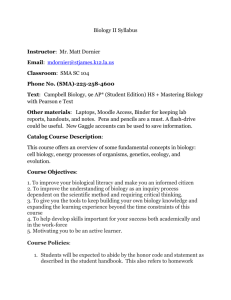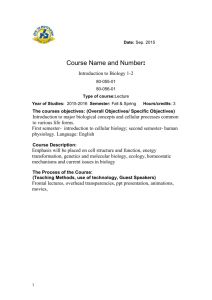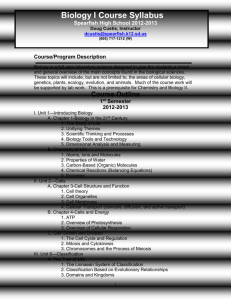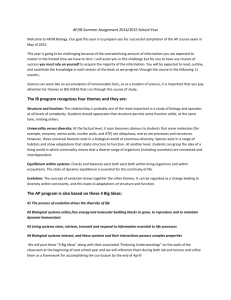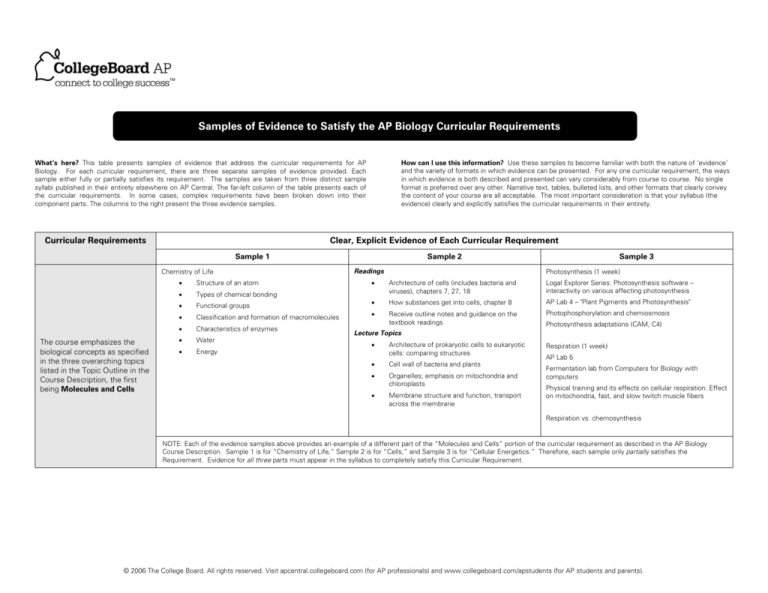
Samples of Evidence to Satisfy the AP Biology Curricular Requirements
How can I use this information? Use these samples to become familiar with both the nature of ‘evidence’
and the variety of formats in which evidence can be presented. For any one curricular requirement, the ways
in which evidence is both described and presented can vary considerably from course to course. No single
format is preferred over any other. Narrative text, tables, bulleted lists, and other formats that clearly convey
the content of your course are all acceptable. The most important consideration is that your syllabus (the
evidence) clearly and explicitly satisfies the curricular requirements in their entirety.
What’s here? This table presents samples of evidence that address the curricular requirements for AP
Biology. For each curricular requirement, there are three separate samples of evidence provided. Each
sample either fully or partially satisfies its requirement. The samples are taken from three distinct sample
syllabi published in their entirety elsewhere on AP Central. The far-left column of the table presents each of
the curricular requirements. In some cases, complex requirements have been broken down into their
component parts. The columns to the right present the three evidence samples.
Curricular Requirements
Clear, Explicit Evidence of Each Curricular Requirement
Sample 1
Chemistry of Life
The course emphasizes the
biological concepts as specified
in the three overarching topics
listed in the Topic Outline in the
Course Description, the first
being Molecules and Cells
•
Structure of an atom
•
Types of chemical bonding
•
Sample 2
Readings
Sample 3
Photosynthesis (1 week)
•
Architecture of cells (includes bacteria and
viruses), chapters 7, 27, 18
Logal Explorer Series: Photosynthesis software –
interactivity on various affecting photosynthesis
Functional groups
•
How substances get into cells, chapter 8
AP Lab 4 – "Plant Pigments and Photosynthesis"
•
Classification and formation of macromolecules
•
Photophosphorylation and chemiosmosis
•
Receive outline notes and guidance on the
textbook readings
Characteristics of enzymes
•
Water
•
Energy
Photosynthesis adaptations (CAM, C4)
Lecture Topics
•
Architecture of prokaryotic cells to eukaryotic
cells: comparing structures
•
Cell wall of bacteria and plants
•
Organelles; emphasis on mitochondria and
chloroplasts
•
Membrane structure and function, transport
across the membrane
Respiration (1 week)
AP Lab 5
Fermentation lab from Computers for Biology with
computers
Physical training and its effects on cellular respiration: Effect
on mitochondria, fast, and slow twitch muscle fibers
Respiration vs. chemosynthesis
NOTE: Each of the evidence samples above provides an example of a different part of the “Molecules and Cells” portion of the curricular requirement as described in the AP Biology
Course Description. Sample 1 is for “Chemistry of Life,” Sample 2 is for “Cells,” and Sample 3 is for “Cellular Energetics.” Therefore, each sample only partially satisfies the
Requirement. Evidence for all three parts must appear in the syllabus to completely satisfy this Curricular Requirement.
© 2006 The College Board. All rights reserved. Visit apcentral.collegeboard.com (for AP professionals) and www.collegeboard.com/apstudents (for AP students and parents).
Curricular Requirements
Clear, Explicit Evidence of Each Curricular Requirement
Sample 1
The course emphasizes the
biological concepts as specified
in the three overarching topics
listed in the Topic Outline in the
Course Description, the second
being Heredity and Evolution.
Biotechnology (2 weeks)
Topics
• DNA historical background, experimental evidence
• DNA and RNA structure
• DNA replication in detail, experimental evidence
• Protein synthesis, transcription, and translation
• Mutations
• Biotechnology techniques: cloning, PCR, principles of
electrophoresis, RFLP analysis
Reproduction (1 week)
Topics
• Significance of mitosis and meiosis
• Cell cycle
• Mitosis in plants and animals
• Meiosis in plants and animals
• Chromosomal abnormalities due to non-disjunction
• Cancer
Reproduction and Embryology (2 weeks)
Topics
• Basic embryological terms
• Comparison of development stages in echinoderm,
frog, chicken, and human
• Extra embryonic membranes in chicken and human,
and their importance
• Human anatomy, male and female
• Menstrual cycle
• Human development to birth
Class Activity
• Students watch the video Chick Embryology.
• Guest (physician and local public health official) leads
discussion on sexually transmitted diseases.
Genetics (2 weeks)
Topics
• Mendelian genetics, probability, segregation,
independent assortment
• Non-Mendelian patterns, codominance, pleiotropy,
epitasis, polygeny
• Human genetics, pedigree analysis
• Sex linkage, autosomal linkage, linkage maps
• Drosophila genetics, setting up a cross
• Chi-square
• Eukaryotic chromosome
• Control of gene expression, Lac Operon
Evolution and Past Diversity of Life (2 weeks)
Topics
• Historical background behind Darwin’s theory; voyage
of the Beagle
• Evidences for evolution
• Evolution in action today
• Modern synthesis, population genetics, HardyWeinberg law of genetic equilibrium, problems
• Natural selection, microevolution events, types of
selection, preservation of variation
• Speciation, prezygotic and postzygotic mechanisms,
allopatric and sympatric speciation
• Gradualism/punctuated equilibrium
• Fossil record, extinctions, dating of fossils
Sample 2
Cell Division and Genetics
Cell Division (2 weeks)
Sample 3
Cellular Reproduction (Chapters 12, 13, 46, 47, PickettHeaps article)
Introduction to chromosomes and their anatomy
•
Stages involved in mitosis
AP Lab 3 - "Mitosis and Meiosis"
•
Stages involved in meiosis
•
Alternation of generations
•
Spermatogenesis and Oogenesis
Mitosis internet tutorial from the University of Arizona
biology project
Meiosis and gametogenesis: Logal Explorer Series:
Genetics software -­tutorial on meiosis
Lab: Mitosis and Meiosis (AP Lab 3)
Lab: Embryology of the Sea Urchin (teacher generated)
Cell factors affecting genetic variation
Crossover ratio activity
Mendelian Genetics (1.5 weeks)
Mendelian principles with applications to monohybrid and
dihybrid crosses
AP Lab 7 - "Genetics of Organisms" Computer simulation:
Logal Explorer Series: Genetics software -­ genetic crosses
Human Genetics (1.5 weeks)
Mendelian and Non-Mendelian Genetics (Chapters 14, 15)
•
Inheritance patterns: monohybrid, lethal, sexlinked, codominance, multi-hybrid crosses
•
Lab: Genetics of Organisms (AP Lab 7)
Molecular Genetics (Chapters 16, 17, 19
Blackburn article)
•
RNA and DNA structure and function
•
Structure of prokaryotic and eukaryotic
chromosomes
•
Gene regulation in prokaryotic and eukaryotic
cells
Mutational change at the chromosome and molecular levels
Genetic conditions affecting humans
Karyotype analysis activity
Evolution (Chapters 22, 23, 24, 25, Miller article, Pruitt
article)
Molecular Genetics (5 weeks)
•
Chemical evolution
Introduction to the structure of DNA and RNA
•
Evidence
DNA isolation activity: Isolation from onion cells
•
Mechanisms
Regulation and function of genes: Logal Explorer Series:
Molecular Biology software – molecular biology simulations
Genetic engineering: Logal Explorer Series: Molecular
Biology software – molecular biology simulations, BSCS
Lab: Population Genetics and Evolution (AP Lab 8)
Lab: Coacervates (from McMullen, Newton, and Becker)
Advances in genetic technology RFLP analysis, BSCS
advances in genetic technology gene splicing activity, AP
Lab 6 - "Molecular Biology"
Term paper: The ethics of gene manipulation
Evolution (2.5 weeks)
Evidence of evolution
Mechanisms of evolution: AP Lab 8 - "Population Genetics
and Evolution," speciation Comparative vertebrate anatomy
lab: Shark, perch, frog, fetal pig (evolution of respiratory,
digestive, and circulatory systems are traced). This takes
place through the "Structure and Function of Animals" unit
but ties in to evolution. A lab exam follows.
© 2006 The College Board. All rights reserved. Visit apcentral.collegeboard.com (for AP professionals) and www.collegeboard.com/apstudents (for AP students and parents).
Curricular Requirements
Clear, Explicit Evidence of Each Curricular Requirement
Sample 1
Microbiology - Chapters 26, 27, 28, 31
Lab: Gram Staining (from Harley and Prescott)
Lab: Life Cycle of Dictyostelium discoideum (from Droter)
Sample 2
Ecology and Behavior – Chapters 50, 51, 52, 53, 54, 55
First-Term Project: Radish Seed Experiment
Labs
•
Dissolved O2
Plants - Chapters 29, 30, 35, 36, 37, 38, 39
•
Choice Chambers
Lab: Plant Pigments and Photosynthesis (AP Lab 4)
•
Biological Magnification
Lab: Transpiration (AP Lab 9)
•
Biomes
•
Winogradsky Column
Invertebrates - Chapters 32, 33
Lab: Dichotomous Key to the Insects (Keeton, Dabney, and
Zollinhoffer)
Lab: Dissection of the Earthworm and Clam (teacher
generated)
Three Domains, Phylogenetic Trees, Prokaryote and
Eukaryote Diversity, Animal Phylogeny and Diversity,
Animal Development – Chapters 21, 27, 28, 32, 33, 34,
47
Labs
Vertebrates - Chapters 34, 40, 41, 42, 43, 44
•
Earthworm Dissection
Lab: Dissection of the Frog (teacher generated)
•
Crayfish Dissection
•
Examining Choanoflagellates
Comparative Anatomy and Physiology - Chapters 45, 46, 47,
49, Penton-Voak article, Simanton article
The course emphasizes the
biological concepts as specified
in the three overarching topics
listed in the Topic Outline in the
Course Description, the third
being Organisms and
Populations.
Plants – Chapters 29, 30, 35, 36, 37, 38, 39
Lab: Physiology of the Circulatory System (AP Lab 10)
Lab: Sheep’s Brain and Cow’s Eye (from Marieb)
Ecology - Chapters 50, 51, 52, 53, 54, 55
Labs
•
Transpiration
•
Flower Dissection
•
Fruits
Lab: Dissolved Oxygen and Aquatic Primary Productivity (AP
Lab 12)
Lab: Biotic Index (from Burd, Carey, and Fowler)
Digestion, Circulation, Gas Exchange, Homeostasis
(excretory systems), Immune System – Chapters 40, 41,
42, 43, 44
Hormones and Reproduction, Nerves, Muscles, Sense
Organs – Chapters 45, 46, 48, 49
Fourth-Term Project: Owl Pellet Investigation
Labs
•
Pulse Rates
•
Daphnia
•
Fetal Pig Dissection
Sample 3
Survey of Animals/Protists and Classification Concepts
(2 weeks)
Class Activities
• Review terms like prokaryotic/eukaryotic and
autotroph/heterotroph, and terms used in classification
and the formation of phylogenetic trees, like symmetry,
and types of coelom
• Receive outline notes and guidance on the textbook
readings and the major phyla
• Observe specimens and practice placing the organisms
on the phylogenetic trees
The Plants (2 weeks)
Topics
• Alternation of generations
• Angiosperm structure and growth
• Angiosperm reproduction and growth
• Plant control systems
Class Activity
• This topic has a “look, see, feel format,” and I bring in
specimens of flowers and do a simple lab to show the
floral anatomy when I am teaching plant reproduction.
• Students usually do some basic planting activities like
stem cuttings and planting a seed. They generally enjoy
this because they are city kids and know very little
about how things grow.
• Videos like Sexual Encounters of the Floral Kind close
the unit.
Animal Structure and Function (3–4 weeks)
Topics
• Basic principles of anatomy, with an emphasis on
mammalian systems
• Digestive system structure and function
• Heart and circulatory system
• Respiratory system
• Immune system
• Osmoregulation and the excretory system
• Endocrine system: homeostasis, sugar and calcium
control, review of sexual hormones
• Nervous system: plan of the nervous system, neuron
structure, reflex arc, transmission of nerve impulse
• Muscular system: voluntary and involuntary muscles,
muscular contraction
• Review of human reproduction and embryology
Class Activity
Class Discussion – Design an experiment to
determine why there is an inverse relationship
between body size and metabolism.
Ecology (2 weeks)
Topics
• Biomes: aquatic and terrestrial biomes and the factors
that influence them
• Community ecology, ecological succession, soil and its
role in succession
• Ecosystem ecology, trophic structure, and productivity
• Population ecology
• Global Issues
© 2006 The College Board. All rights reserved. Visit apcentral.collegeboard.com (for AP professionals) and www.collegeboard.com/apstudents (for AP students and parents).
Curricular Requirements
The course provides students
with an opportunity to develop
a conceptual framework for
modern biology emphasizing
evidence of an understanding of
science as a process rather
than an accumulation of facts.
The course provides students
with an opportunity to develop
a conceptual framework for
modern biology emphasizing
recognition of evolution as the
foundation of modern biological
models and thought.
Clear, Explicit Evidence of Each Curricular Requirement
Sample 1
Sample 2
Sample 3
Most of the time I have students end their labs by
answering the questions in the lab manual or writing a brief
evaluation (i.e., writing an analysis, conclusion, limitations,
and recommendations) of the lab. When a full lab report is
required, I instruct students to include the following
elements in it: title, introduction/background information,
purpose (the specific topic being investigated), procedure,
data/results, analysis, conclusion, limitation, and
recommendations.
All students who take the AP Biology course are required to
do an independent research project outside of class time. I
assign this in September and it is due at the beginning of
March. Students do most of the work on it independently
and at home. Every year our high school holds a large
science fair, and most of the AP Biology students compete
with their projects and win prizes at both the regional and
state levels. We also have semifinalists every year in the
Intel Science Talent Search competition; although these
students are seniors, they sometimes win awards for the
projects they did during their sophomore year in AP Biology.
In the past, students have isolated new phages and
annotated their genomes, constructed phylogenetic trees
from genome databases using MacClade 4 and PAUP
software, and tested the effects of spices and antibiotics on
different kinds of bacteria.
To stress biology and science in general as a process, lab
activities stress development and testing of the hypothesis;
collection, analysis, and presentation of data; and a clear
discussion of results. Formal reports are required, and
must include the aforementioned elements, plus proper
labeling of tables and graphs, and statistical testing is
encouraged wherever possible.
Most of my lectures are based on the factors used in
making phylogenetic trees (e.g., the basics of embryology,
symmetry, origin of the eukaryotic cell, etc.)
I try to bring up evolution in every unit by using the
phylogenetic trees I have developed over the last few years
(see the student activities section of this syllabus for an
example). When we do cell respiration, for instance, I point
out that the fact that glycolysis is found across all three
domains (Bacteria, Archaea, Eukarya) means it was present
in the universal ancestor who lived 3.3 to 3.5 billion years
ago. The fact that the genetic code is universal (the same
genetic code in all three domains) is also powerful evidence
for evolution.
Evolutionary themes, which clearly unify all biology
disciplines, are often ignored in standard biology courses. In
order to bring together prevailing themes about evolution to
every unit, the course is divided into 4 frameworks Physical and Chemical Mechanisms, Historical, Organisms,
and Populations. The idea of ‘change in a population over
time’ is highlighted through labs, homework assignments,
lectures and readings in each framework.
© 2006 The College Board. All rights reserved. Visit apcentral.collegeboard.com (for AP professionals) and www.collegeboard.com/apstudents (for AP students and parents).
Curricular Requirements
Clear, Explicit Evidence of Each Curricular Requirement
Sample 1
Every unit includes an exercise designed to integrate the
topic of that unit into the eight major themes of the AP
Biology Course Description. Throughout the time spent on
each unit, we discuss as a class how the topic at hand
relates to and fits within each theme, and how these
themes transcend all of the unit topics. For example, in Unit
1 (Ecology and Behavior),
Theme 1 – Science as Process – Students engage in a
project (Radish Seed Experiment) demonstrating the use of
scientific reasoning to solve a problem.
Theme 2 – Evolution – Students compare ecological time
with evolutionary time and examine how they correspond.
Theme 3 – Energy transfer – Students are asked to describe
the movement, conversion, and storage of energy within an
ecosystem, usually originating with the sun, then stored and
converted to chemical energy by autotrophs (and then is
passed on to heterotrophs) and/or dissipated as heat.
The integration of the general
topics of biology through the
eight major themes as specified
in the Course Description Science as Process; Evolution,
Energy Transfer; Continuity and
Change; Relationship of
structure to function;
Regulation; Interdependence in
nature; and Science,
technology, and society
Theme 4 – Continuity and change – Students are asked to
consider how specific changes
to an ecosystem
(geological, climatic, introduction of new organisms, etc.)
can
affect the organisms that live within it.
Theme 5 – Relationship of Structure to Function – Students
consider how organisms are physically adapted to survive
and reproduce in their environment.
Theme 6 – Regulation – Students are to understand how an
organism’s regulatory mechanisms (such as those that
control body temperature) serve to aid or hinder its survival
in particular environments.
Theme 7 – Interdependence in Nature – The very key to
ecology – how organisms interact within their environment,
and how they cannot survive without such interactions.
Theme 8 – Science, Technology and Society – Students are
asked to consider how the
population growth of
human beings has influenced local ecosystems throughout
history, and how it continues to do so, even to the extent of
affecting the entire
biosphere.
Sample 2
All the topics in the AP Biology Course Description are
integrated throughout the course using the eight major
themes from the AP Biology Curriculum Requirements.
…
From “Sample Lecture Outline”
“Lecture Unit 6: Chapter 14, “Mendel and the Gene
Idea”
Sample 3
The first semester begins with orientation and a discussion
on how to use the Campbell/Reese textbook, emphasizing
the “Ten Themes in the Study of Life,” which are very
similar to the “eight major themes” found in the official
curricular requirements of AP Biology.
…
Mendel’s Laws (regulation)
From “Unit 2 - Evolution and Past Diversity of Life” - Class
discussion: How does the present period of mass extinction
compare to those of the past? (continuity and change)
Mendel’s experiments (science as process)
…
…
From” Unit 3 - Ecology” - Students are asked to find an
example of the introduction of a non-native species to an
environment. The one getting closest to our own biome
wins a prize, and is asked to help lead a class discussion
about how that organism has affected the local
environment. (interdependence in nature)
The advantages in adaptation of sexual reproduction
(evolution)
Genetically determined traits tend to propagate through
generations as a result of selection by, among other things,
attraction to mates (favorable) and predators (unfavorable)
(interdependence in nature).
…
Pleiotropy—the ability of a single gene to have multiple
effects on an organism e.g., sickle cell anemia – Although a
serious disease, the gene may actually provide a resistance
to malaria by making red blood cells more fragile than
normal, interrupting the lifecycle of the disease-causing
microorganism. So a structural anomaly in the proteins of
the cell that would be a disadvantage in other
circumstances actually provides an advantage in areas
where malaria is common. (relationship of structure to
function)
…
Pedigree analysis (continuity and change)
…
Technology used in genetic counseling and testing
(science, technology and society)
…
From “Unit 5 - Cell and Cell Functions” - Class discussion –
What characteristics of cells provides evidence of a
common origin? (evolution)
…
From “Unit 7 - Biotechnology” - Class Discussion – Should
insurance and other health care related companies have the
right to screen and discriminate based on the presence or
absence of potentially disorder-producing or diseasecausing genes in their clients? (science, technology and
society)
…
From “Unit 9 - Reproduction and Embryology” - Guest
(physician and local public health official) lectures and leads
discussion on sexually transmitted diseases. (science,
technology and society)
…
From “Unit 1 - Photosynthesis and Respiration” - The role
of photosynthesis and respiration in global warming.
(energy transfer)
…
From “Unit 13 - Animal Structure and Function” - Design an
experiment to determine why there is an inverse
relationship between body size and metabolism.
(relationship of structure to function and science as
process)
…
From “Unit 14 – Review” - The class is divided into eight
groups, with each group corresponding to one of the major
themes in the AP Biology Course Description. Assign each
group the task of providing one example of how their major
theme relates to each of the units covered in the course.
Over several days, one person per day from each group is
then selected to present their examples.
NOTE: The integration of the general topics through the eight major themes will require evidence throughout the syllabus, as in Samples 2 and 3 above.
© 2006 The College Board. All rights reserved. Visit apcentral.collegeboard.com (for AP professionals) and www.collegeboard.com/apstudents (for AP students and parents).
Curricular Requirements
Applications of biological
knowledge and critical thinking
to environmental and social
concerns.
The course includes a
laboratory component that
fulfills all of the objectives of
the recommended AP Biology
labs as listed in the Course
Description. Students must
spend a minimum of 25% of
instructional time engaged in
hands-on laboratory work.
Clear, Explicit Evidence of Each Curricular Requirement
Sample 1
Sample 2
The class is organized into two groups, pro and con, based
on a controversial issue in biology. The students select 3
leaders to represent their side of the panel. Members of
each group provide the panel with information to help them
win the debate. The winning side formulates the most well
documented counter-arguments. The side that wins the
debate is treated to lunch, usually pizza, the day before
school ends for the winter break. This is a non-graded
assignment. Topics have included stem cell research and
female preference in dating.
The STSE (Science-Technology-Society-Environment)
approach is the basis of our curriculum and this leads to the
use of discussion and journals in the classroom. Students
are given readings from current journals and newspapers
and are asked to write journal articles based on the article’s
content and the ethical concerns that arise from the articles.
I cover all of the labs in the AP Biology Lab Manual for
Students, either exactly or modified to fulfill my course
objectives. This requires about one day out of four devoted
to lab work.
Classes meet every day for 50 to 55 minutes. Once a week
we have a double lab period that runs between 105 and 115
minutes, depending on the vagaries of a complicated
schedule. This makes it possible to not only do all of the 12
labs in the AP Lab Manual for Students but many additional
labs as well, resulting in a very rich laboratory program.
Sample 3
In addition to the science sections of newspapers and
popular science magazines, I employ such journals as
Science and Nature as resources throughout the course,
thus making modern environmental and social concerns
associated with biology a continuing theme.
Day 1
Day 2
Day 3
Day 4
Day 5
Lecture 1
Lecture 2
Lecture 3
Lecture 4
Review
Day 6
Day 7
Day 8
Day 9
Day 10
AP Lab
AP Lab
Other Lab
Recitation/Lab
Unit Exam
Free-Response
Question
Practice
NOTE: A listing of all lab activities should be included, with a short description of each, and also with evidence that the total lab time is at least 25% of the total instructional time. When
labs from the AP Biology Lab Manual for Students are used, no descriptions are necessary, only which labs are used where. However, it still must be clear that lab time is at least 25%.
© 2006 The College Board. All rights reserved. Visit apcentral.collegeboard.com (for AP professionals) and www.collegeboard.com/apstudents (for AP students and parents).




